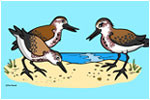| |
|
Chapter 3: Maya's Unique Design 
Jorge thinks I worry too much and tries to relax me by focusing on all the amazing qualities that we have. He gets very excited when he lists off to me the remarkable number of adaptations that help us survive. He insists that we are unique and different than other birds--and much better (but how would he know?). One thing is for sure: an adaptation gives us an advantage, or an edge, for survival in our wetland habitats.
According to Jorge, my entire body--from the tip of my bill to my tiny toes--is uniquely designed so that I can survive more easily in a wetland habitat. This means that I am "physically adapted" I am told. Last night as we were feeding by the shadow of the moon, Jorge rambled on and on about how I need to begin to appreciate how lucky we are. These are the reasons he gave:
- Our bills are like surgical instruments that can probe the mud for tiny animals and work just beneath the surface. (And Papa reminds us that our bills are also important for building nests and courtship as well.)
- My long, pointed wings allow me to fly long distances at a fast speed during migration. In fact, some of my shorebird friends can fly 50 miles per hour. If I had short, stubby wings, I wouldn't be able to fly great distances, or I'd have to migrate slower and stop more often, which would slow me down.
- I have hollow bones that keep me "light as a feather." They help make flying easier.
- I have large air sacks that supply me with lots of oxygen to nourish my flight muscles. I fly hours and hours at a time.
- Located at the base of my tail I have an oil gland. Even though I live in and around water, I like to stay dry. Oil from my gland keeps my feathers waterproof--it's like an instant raincoat that goes with me everywhere I go. All I do is preen my feathers with the oil using my bill or the back of my head. The oil also keeps my feathers clean.
- My long legs allow me to wade in water or mud while my long toes give me stability when walking, kind of like wearing the right types of shoe. I don't swim so I don't need webbed feet.
Certainly this means that our chances of survival are greater--and I feel much better. I thank Jorge for reminding me of these advantages. Oxy interrupts me by raising her beak from the sand and screeching from the mudflat, "You can't argue with that. Now, that's enough talking--you'd better get eating." She gets easily annoyed with Jorge for being a know-it-all, but the truth is that she is right. Almost every minute must be used to build our fat reserves--which to humans is like extra gas for a car. The food we eat is the energy that allows us to fly for long distances without stopping. So last night was a long night of stuffing our faces with as many little pink clams as we could get our beaks on. Thank goodness we have long, pointed beaks to help with this job. Well, I'm going off to use my bill right now!
|
|
|
|
